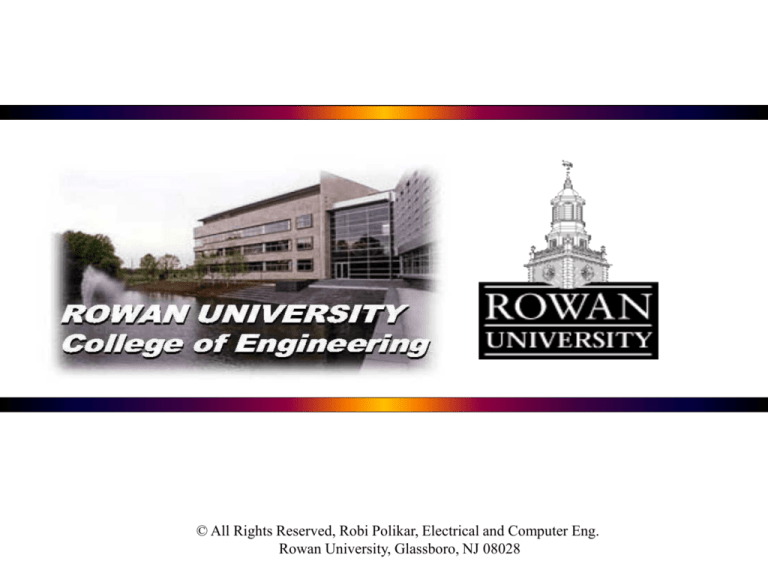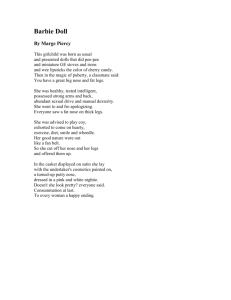
© All Rights Reserved, Robi Polikar, Electrical and Computer Eng.
Rowan University, Glassboro, NJ 08028
Did you ever measure a smell? Can you tell whether one smell is just
twice strong as another? Can you measure the difference between
one kind of smell and another? It is very obvious that we have very
many different kinds of smells, all the way from the odor of violets
and roses to asafetida. But until you can measure their likeness and
differences, you can have no science of odor.
If you are ambitious to find a new science, measure a smell.
Alexander Graham Bell (1914)
The Department of
presents…
Emerging Interdisciplinary Challenges
Robi Polikar
October 16, 2002
Outline
Introduction: emerging interdisciplinary challenges
Motivation and background
The mammalian olfactory system vs. the electronic nose
Commercially available electronic nose systems
Quartz crystal microbalances
Experimental setup
Identification of volatile organic compounds (VOCs)
An uncooperative database / sensitivity / selectivity issues
Dealing with an uncooperative database
Automated Identification
Neural Networks
Conclusions
Questions, comments and suggestions
Introduction:
Emerging Interdisciplinary Challenges
Organic Chemistry
Olfactory Physiology
Electronic
Nose
Signal Processing
.
.
.
.
.
Pattern Recognition
Chemical Sensors /
Analytical Chemistry
Computational Learning
Introduction
Motivation & Background
Many industries, institutions and organizations can benefit from
a device capable of identifying odors:
Food industries: detection of food quality / wholesomeness
Airport security: drug smuggling, detection of explosives
Anti-personnel land-mine detection
Detection of household chemicals
Detection of hazardous gases
VX, CO, radon, etc
Detection of volatile organic compounds
Wastewater odor control
Selectivity & Sensitivity
Issues
• Humans can identify 10000 types of odors at varying sensitivity levels.
• 10000 odors are considered to be combination of a few basic types of odors:
floral, musky, camphorous, pepperminty, ethereal, pungent (stinging), and
putrid (rotten).
• Another group of researchers believe that this number is actually around 50.
• More recently, it has been suggested that there are actually over 1000 smell
genes in the nose, each of which encodes a unique receptor protein.
• Sensitivity: 5.83 mg/L of ethyl ether,
3.30 mg/L of chloroform,
0.0000004 mg/L of methyl mercaptan (1/25 trillionth of a gram)
Mammalian Nose Vs.
Electronic Nose
Mammalian Nose
Receptor neuron
Odorant binding protein
10000000 receptors
Sens.
Electronic Nose
Sensor / transducer
Coating
6-30 sensors (array)
Glomeruli
Signal processing module
Brain
Pattern recognition module
1 part per trillion
Selec. 10000~20000 odors
1 part per million
<50 odors
Electronic Nose
Systems
Odorant Molecules
Chemical Information
CIM Coated Sensor
Raw electrical signal
Sensor Processor
Processed Electrical signal
Signal Processor
Denoised Electrical signal
Feature Extractor
Relevant features
Knowledge
Base
Pattern Recognition
Training
&
Testing
Identification
Sensor Technologies
Metal Oxide Semiconductor sensors (MOS)
Chemical Field Effect Transistors (ChemFET)
Conducting Polymers (CP)
Fiber Optical Sensors (FOS)
Quartz Crystal Microbalances (QCM)
Surface Acoustic Wave devices (SAW)
Mass Spectrometry
Gas Chromatography
Pattern Recognition
technologies
Statistical pattern recognition (SPR)
Bayes classifiers
Discriminant analysis (DA)
Maximum likelihood estimate
Principal component analysis (PCA)
Non-parametric techniques
Artificial neural networks (ANN)
Fuzzy logic (FL)
Rule-based / expert systems
Commercially Available
Systems
Electronic Nose System
Manufacturer
WMA Airsense
Analysentechnik GmbH
Fox x000
AlphaMOS
AromaScan
OsmeTech Inc.
BH114
Bloodhound Sensors Inc.
Cyranose 320
Cyrano Sciences Ltd.
Enose 5000
Marconi Ltd.
Znose 4200
Electronic Sensor Tech.
QMB6 – HS40XL
HKR Sensorsystem GmbH
MOSES II
Lennartz Electronik GmbH
NST 3210
Nordic Sensor Technologies
OligoSense
OligoSense
SAM
Daimler RST Rostock
SMart Nose 300
SMart Nose
VOCmeter
MoTech Sensorik, GmbH
FreshSense
Element Ltd.
4440B
HP – Agilent Technologies
VaporLab
MicroSensor Inc.
Libra Nose
Technobiochip
Sensor
Technology
# of
Sensors
Pattern
Recognition
Algorithms
MOS
10
ANN, DC, PCA
QCM, SAW,
CP, MOS
6-24
ANN, DFA, PCA
CP
48
ANN, FL
CP
14
ANN, CA, DA,
PCA
?
U.K.
CP
32
PCA
5,000
USA
QCM, MOS,
CP, SAW
8-28
ANN, DA, PCA
?
U.K.
SAW, GC
6-15
SPR
19,50025,000
USA
QCM
6
ANN, PCA
?
Germany
QCM, MOS
16
ANN, PCA
?
Germany
MOS, FET,
QCM
22
ANN, PCA
40,00060,000
Sweden
CP
ND/PR
ND/PR
?
Belgium
QCM, SAW,
MOS
6-10
ANN, PCA
50,000
Germany
MS
N/A
DA, PCA
?
Switzerland
QCM, MOS
8
ANN, PCA
?
Germany
MOS
ND/PR
ND/PR
?
Iceland
MS
N/A
Various
Chemometrics
79,900
USA
SAW
2
ND/PR
5,000
USA
QCM
8
ND/PR
5,000
Italy
Price
($)
20,00043,000
20,000100,000
20,00075,000
Country of
Origin
Germany
France
U.K.
Quartz Crystal Microbalances
& Gas Sensing
Bare piezoelectric crystal
Central part of the crystal coated with
first gold, and then polymer material
Electrode
on back
Electrode on front
Crystal holder
W
F 2.3 10 F
A
6
2
Coating Selection
Considerations
For desired levels of selectivity and sensitivity
• Thickness, softness / stiffness, reversibility, operation temperature
Advantages
Disadvantages
Thickness
sensitivity
resistance, phase lag,
attenuation
Softness
response time,
reversibility
Attenuation
Stiffness
Attenuation
Reversibility
Temperature
Softness and hence
response time
sorption and hence
sensitivity.
• Viscoelastic properties: thermal expansion, swelling due to sorption,
film resonance
• Solubility parameters: coating – analyte interactions
VOCs and Coatings Used
Acetonitrile
Acetone
H O H
H C C
H
H
C H
H
Ethanol
H H
N
C
C
H H
CH3C N
CH3CH2 OH
Tricholoroethane
Dicholoroethane
O
APZ
Poly(isobutylene)
PIB
H C C OH
H
H
Apiezon (grease, not a
polymer)
CH3CCH3
Methanol
H
H Cl
H C OH
H C
H
CH3CCl3
Methylethylketone
O
H C C C
H H
C H
Octane
H H H H H H H H
Hexane
H C C
H
Cl
ClCH CCl2
Toluene
CH3
C C C C C C H
H H H H H H
C6H14
Xylene
CH3
CH3
C C C C C C C C H
H H H H H H H H
C8H18
Sol-gel
SG
Poly(siloxane)
OV275
Poly
(diphenoxylphosphorazene)
PDPP
H H H H H H
Cl Cl
H
C2H5COCH3
H
ClCH2CH2Cl
Tricholoroethylene
H
C C H
DEGA
H H
H Cl
CH3 OH
H H
Cl Cl
H
C Cl
Poly
(diethyleneglycoladipate)
C6H5CH3
C6H4 (CH3)2
• 12 individual VOCs at 7 different
concentrations (84 patters).
• 24 Binary Mixtures of VOCs at 16
different concentrations
(384 patterns)
Block Diagram of the
Experimental Setup
PERSONAL
COMPUTER
MASS FLOW
CONTROLLER
CARRIER GAS
(NITROGEN)
VOC
BUBBLERS
NETWORK
ANALYZER
MULTIPLEXER
3-WAY
VALVE
Bi - directional information flow
Unidirectional information flow
Gas flow
SENSOR CELL
6 QCMs
Experimental
Setup
Mass Flow
Controller
Network
Analyzer
PC
Switching
Box
Nitrogen
VOC
VOC in
bubbler
Sensor
Cell
EXPERIMENTAL
SETUP
Mass Flow
Controller
Mass Flow
Meter
Network
Analyzer
Post-It
notes
Sensor
Cell
Gas
Bubbler
Switching
Box
How Does Odor Signal
look Like?
Problems With
Identification Of Mixtures
• Existence of dominant VOCs
APZ: Apiezon,
PIB: Polyisobutelene,
DEGA:Poly(diethyleneglycoladipate),
SG: Solgel,
OV:Poly(siloxane),
PDPP: Poly (diphenoxylphosphorazene)
• Approach: Identify dominant VOC first, and identify secondary VOC
based on the identification of the dominant VOC.
Pattern Separability
Issues
Sensor 2 Measurements
Sensor 2 Measurements
(a)
Sensor 1 Measurements
Measurements from
class 1
class2
(b)
class 3
Sensor 1 Measurements
class 4
(a) Well separated patterns and (b) densely packed / overlapping patterns
Pattern (In)separability
in Mixture VOC Problem
ETHANOL
TOLUENE
XYLENE
Sensor 3
OCTANE
TCE
Identification of VOCs
Raw Sensor Readings (6-D)
Preprocessing
Increasing Pattern
Separability
Filtering, Normalization,
De-trending, etc.
Fuzzy nose (FNOSE),
Feature range stretching, or
Nonlinear cluster transformation
Neural Network
Training
Multilayer perceptron
LEARN++ (for incremental learning)
Neural Network
Validation
Classification
VOC Identification
.
.
.
.
.
Nonlinear Cluster
Transformation
Outlier Removal
x
x2
2
æ
ö
M1 çç å ( m i - m1)÷÷ - m1
è i ¹1
ø
m 5-m 1
m5
m4
m3
x1
m2
m 4-m 1
x1
m 3-m 1
m 2-m 1
m1 Translation
Cluster
1
S i -M i C
x2
å (m j - mi )
C
j 1
x2
Generalized regression neural networks
Nonlinear Cluster Transformation
x1
Similar to RBF networks
Do not require iterative training
Successful in multidimensional
function approximation
x1
PRINCIPLE COMPONENT ANALYSIS
A Comparison
XYLENE
ETHANOL
OCTANE
TOLUENE
TCE
TOLUENE
OCTANE
XYLENE
TCE
ETHANOL
.
.
.
.
.
Artificial Neural Networks
Signals
From sensors
(six)
Output signal based on a
weighted average of input signals
Toluene
Xylene
The Multilayer Perceptron
Neural Network
.
.
.
.
.
d input
nodes
x1
H hidden
layer nodes
x1
wJi
J
xd
d
æ
ö
ç
f netJ å wJi xi ÷
ç
÷
i 1
è
ø
xd
Wkj
netj y
j
netk
zk
..
zc
…
x(d-1)
Wji
z1
..
……....
x2
……...
c output
nodes
æd
ö
ç
y j f net j f å w ji xi ÷
ç
÷
è i 1
ø
(
)
netj
æH
ö
ç
zk f (netk ) f å wkj y j ÷
ç
÷
j
1
è
ø
netk
i=1,2,…d
j=1,2,…,H
k=1,2,…c
Results
Single VOC Identification
7 patterns obtained for each VOC, corresponding to seven
different concentration values between 70 ppm and 700
ppm.
Thirty (30) of the total 12*7=84 patterns were used to train
the neural network.
Remaining patterns were used to validate the performance
of the network
All 54 validation patterns were identified correctly !
Results
Binary Mixture of VOCs
TCE Mixtures
TCE & TL 1
TL Mixtures
5
XL Mixtures
OC Mixtures
ET Mixtures
TL & ACN
0
XL & ACN
0
OC & ACN
0
ET & ACN
0
TCE & MEK 1 TL & MEK
0
XL & ET
0
OC & MEK
0 ET & MEK
0
TCE & TCA
0
TL & HX
5
XL & HX
0 OC & TL1
3
ET & HX
0
TCE & HX
0
TL & ET
0 XL & MEK
0
OC & ET
0
ET & TCA
0
TCE & ET
1 TL & TCA
0 XL & TCA
0
OC & TCA
0
Dominant VOC Performance: 96%
TCE Mixtures
TCE & TL 1
TL Mixtures
0
XL Mixtures
OC Mixtures
ET Mixtures
TL & ACN
0
XL & ACN
0
OC & CAN
0
ET & ACN
0
TCE & MEK 0 TL & MEK
2
XL & ET
2
OC & MEK
0 ET & MEK
1
TCE & TCA
0
TL & HX
3
XL & HX
3
OC & TL2
0
ET & HX
0
TCE & HX
0
TL & ET
0 XL & MEK
1
OC & ET
3
ET & TCA
0
TCE & ET
0 TL & TCA
0 XL & TCA
1
OC & TCA
0
Secondary VOC Performance: 96%
196 (50%) patterns used for training and remaining 196 used for testing.
Conclusions
QCM technology along with neural network identification
can be used as an efficient tool for electronic nose applications
Challenges:
Identification of components in mixtures
Identification of gases at very low concentrations (ppb
levels ?)
Adverse environmental conditions (temperature, humidity, etc.)
New sensor technologies for improved sensitivity and selectivity
Incremental learning of additional odorant (Algorithm: Learn++)
Questions






